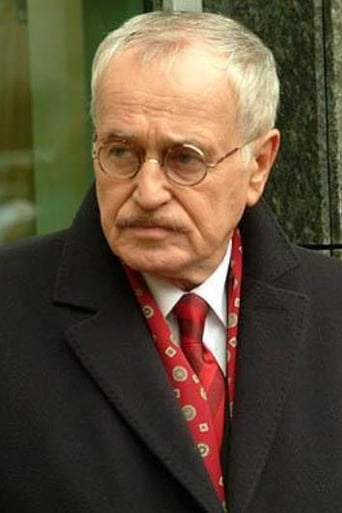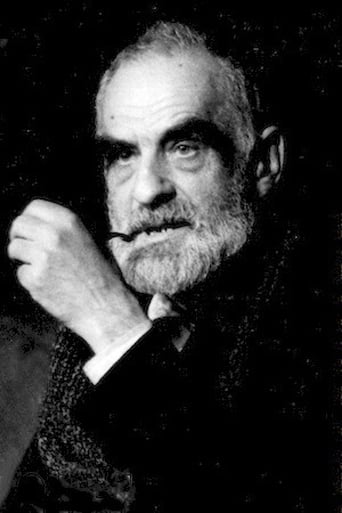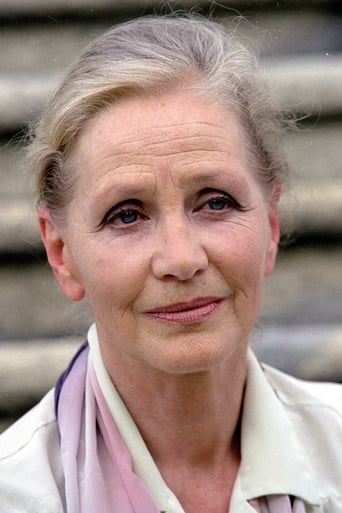Diagonaldi
Very well executed
Pacionsbo
Absolutely Fantastic
Chirphymium
It's entirely possible that sending the audience out feeling lousy was intentional
Brainsbell
The story-telling is good with flashbacks.The film is both funny and heartbreaking. You smile in a scene and get a soulcrushing revelation in the next.
jadavix
Andrzej Zulawski's first feature film, "The Third Part of the Night", is not as talky as his later films, but is just as impenetrable. It features a man whose family is murdered by Nazis at the beginning of the movie, who then runs away, helps deliver a baby in a graphic sequence, apparently poses (or actually becomes) an insurance salesman, haunts a hospital where he has strange talks with an obscure nurse, and ends up volunteering for a program where he is vaccinated against typhus and is munched on by lice to help doctors find a cure.I really lost the plot after that, but the ending does have him finding himself, or a doppelganger, in a hospital bed.We are used to dialogue to provide exposition and reveal aspects of character. The dialogue in this movie only confuses the watcher further. The movie feels rough and wild, with violence and ugliness and insanity coming out of nowhere. It was also revolutionary for its use of hand-held camera, putting you in this world, and making you feel even more disorientated.
chaos-rampant
I don't like to treat movies as simply fictions to pass the night, that way lies the habit of simply partaking of culture. The whole point is that we're roped in life by forces that have significance for us - and if film is to be a truthful reflection, it will devise ways to portray this pull, turn it into something we can see.This is how I welcome Zulawski. It's not because of what he has to say or because themes might be important, here Polish life under Nazi horrors. Similarly I don't reject him because stories are muddled or the acting is hysteric. I welcome him because he can use the eye of the camera to rope forces that move us.On the surface this is a glimpse of anguished life during WWII, but not the mock historical type that seeks to enshrine bygone events in pious ceremony. This is one that speaks very much about anxiety that haunts the soul now in this very life, rending the air with dread and confusion. Horror that is very much present and didn't go away with the war but still lingers. He would rail - more or less covertly - against a repressive Soviet regime in later films as well.So he's angry with god that won't manifest, he shouts dejection at a broken state of things, everything he would become known for is already present here, fully formed as template. But no answer can be found in the mind that despairs and clamors and none would suffice to explain anything. No his power is that he can show these things truthfully for what they are, confusion as confusion, ignorance as ignorance. So of course the narrative becomes oblique, muddled, sense takes flight and we're left with fragments.He's still striving to burst forth here, not yet channeling madness through the eye to alter how we see. That would come to him in due time. But everything you need to know about him you'll see in the very beginning of this first film.A man's wife and child are taken from their house one day and murdered in the yard; evil that swoops over this world and wrecks lives. He joins the resistance and immediately people are chasing after him and shooting to kill him, agents of that evil. So he hides in an apartment building and by a chance turn of fate, police arrest someone else in his place, someone with the same color of coat who was going up the stairs to a pregnant wife. In a stunning turn he helps the wife give birth, becoming the husband who was taken away.Jancso and Tarkovsky were previous masters of the floating eye who could maintain equanimity in the face of horror and misfortune; he is ruptured by it, splintered in selves. But it's still the same deep roar from the engines of consciousness that propels him.
tomgillespie2002
Remarkably, this was Polish director Andrzej Zulawski's debut feature. Coming from a family full of actors, directors, poets, writers, and general great thinkers, Zulawski strides into this film with confidence, focus and a craft that takes the majority of directors years to perfect. I was interested in this film after reading about the rather strange plot line, and having a keen interest in Polish cinema, notably the work of Roman Polanski and Andrzej Wajda. And I'm pleased my I followed my curiosity, as the film is a hypnotic and nightmarish piece of cinema that encourages discussion, interpretation and repeat viewings, something that I find with only a few films, especially straight after the first viewing.The film begins in a remote countryside house in Nazi-occupied Poland, where Michal (Leszek Teleszynski) stays with his wife and children, until the Nazis come along a murder everyone while Michal lies hidden in the woods. He journeys back to Lwow where he joins the resistance, almost instantly being tracked down and almost murdered. He manages to escape when the pursuers mistake an innocent bystander wearing similar clothes to be him and shoot him dead. Michal comforts the dead man's wife, while noticing that the mysterious woman bears an uncanny resemblance to his own dead wife. Being a typhus sufferer, Michal decides to put his misfortune to use and earns money becoming a lice feeder, strapping small boxes full of the bloodsuckers down his legs to let them feed, which are later used to develop a vaccine.What stems from the relatively normal opening scene can only be described as a chaotic descent into instability, as the story moves along slowly and confusingly. The decision to use the same actress (Malgorzata Braunek) to play multiple roles is never clearly explained or made clear. The obvious and initial reason would apparently be the inability of Michal to let go of his wife's death, seeing her everywhere, but as the film goes on, you wonder about the mental stability of our hero, or even ponder if this (or indeed the whole film) is just a product of his typhoid-addled brain. Scenes randomly blend into the next, and you have no idea where the film is going or will end up. It is truly a mentally tiring experience, and all the better for it.Zulawski seems to be fascinated with lice and the feeding process that the film depicts. He films in close detail, with some effectively loose- hand held work, how the lice are packed together in a tiny box, with a mesh screen in place to allow the creatures to feed through. Later, during the vaccination process, we are treated to a microscope POV of the lice being carefully placed on a petri dish one by one, only to be torn open by a pair of tweezers to extract their infected blood. Do the lice represent our protagonist, or the nature of the human race? Or perhaps it's a commentary on the war and the destruction of the Nazi party? No answers are clear with the film, and is best enjoyed as an interpretive piece of art cinema. I use the word 'enjoy' loosely, as when the climax approaches, it almost becomes a piece of psychological horror, one that genuinely disturbs in a way that only a true artist can achieve.It will not appeal to everybody, but no matter what your view or opinion, it will no doubt have a profound effect on the emotions and the brain, and will linger for a long time.www.the-wrath-of-blog.blogspot.com
oOgiandujaOo_and_Eddy_Merckx
The Third part of the night is set in Poland during the second world war, which, as you will probably know, was infested by the plague of Nazism, and latterly equipollent Communism. The film starts with a quotation from Revelations Chapter VIII, which delineates the havoc that will be wreaked upon the earth when the Big Guy decides it's time to wrap everything up. There are seven trumpets being blown, the first four we are told about, and they wreak chaotic damage to earth, generally in thirds: a third of the rivers are turned to wormwood, one third of ships destroyed... Anyway the fourth trumpet makes it so that for a third part of the night the moon and stars will not shine, so that's basically what the German occupation of Poland is, the Third Part of the Night.Most of the film is set in the city of Lwow, which was then part of Poland, but now has been made part of Ukraine and is called Lviv. That was Joe Stalin's doing, part of his Polish Holocaust.The film starts though in the countryside with a violent act that is a quotation of the violence at the start of Menilmontant if I have seen things correctly. Michal the main character, a ghost-faced unibrowed typhus sufferer loses his family and returns to Lwow, where he attempts to become part of the resistance. It turns out that the resistance centers around a research institute. The folks there exist to feed lice. The way it works is that you put a strap around your bare leg and slot in these matchbox size containers full of lice that feed from your blood through a wire mesh. These lice are used to breed typhus, and the vaccine is then prepared from their guts. One guy gets home from work, strips naked and starts scratching himself and whimpering. Not the most pleasant scene. Involving yourself in this process gave you great papers though, because the Germans took one look at your papers, and were then scared of catching typhus from you and so left you well alone.After losing his wife, Michal comes across a woman who looks exactly like her (a plot device Zulawski also uses in La Femme Publique). It's not clear why this device is used, but it could be a misogynist motif, ie. he's incapable of seeing the woman for who she is, he may also be having a traumatic hallucination, which would mean that there is a woman but she doesn't look like his wife. This *hallucination* of a movie is mainly anchored around this plot, providing some sort of bearing for the viewer.You won't see a normal moment in the entire movie, everything is topsy turvy, every scene is either in a shattered building, or of a normal building full of shattered people. It's a nightmarish movie, like a dance of death. Dance is an appropriate word because the film uses hand-held camera a lot (though Zulawski in an interview has stated that the cameraman he found had a very steady hand, and he was obviously proud to find him), and the shot dances around, with some circular shots, zooms you never see coming, really it's very alive.What really is the Zulawski strength though is directing actors, he managed to coax scenes of incredible intensity out of Malgorzata Braunek (as Michal's wife) and Jerzy Golinski (Michal's father). I've seen almost nothing like it, though another Polish film springs to mind, Jerzy Kawalerowicz's Mother Joan of the Angels. The actors handed themselves over to Zulawski, giving them his complete trust, Braunek in particular in one scene at the institute connected with some deep innermost primal emotions.The cellar shots at the institute are the bleakest shots you're likely to see in cinema, and remind me only of paintings, and bizarrely of the shots of test chambers in Alien 4.The only big stumbling block for most people I believe would be the music, which is very out-of-place jazz (three quarters of the way between mellifluence and dissonance), and has taken me a while to get used to.








